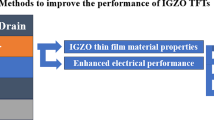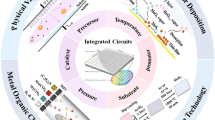Abstract
In this paper, we implement the pulsed current–voltage (PIV) technique for the metal-oxide-semiconductor field-effect transistor (MOSFET) device’s ultrafast characterization based on the OpAmp amplifier OPA818. The latter dropped down the measurement time for a whole MOSFET characteristic to \({{t}_{M}}\) = 50 ns as an enhancement. Furthermore, a study concerning the technique’s dependency on measurement time (\({{t}_{M}}\)), channel length (\(L\)), and channel width (\(W\)) is accomplished. It is found that the distortion in the technique’s results, labeled as hysteresis, is inversely proportional to measurement time and it increases dramatically with very low values of \({{t}_{M}}\). Also, the results show that PIV could have a somehow direct proportionality to channel length, and it is justified by the gate/drain capacitance (\({{C}_{{{\text{gd}}}}}\)) effect. On the other hand, the technique shows no dependency on channel width at all. Moreover, as measurements limitations, the results couldn’t record drain currents less than \({{I}_{{{\text{ds}}}}}\) ≈ 10–7 A, this makes PIV limited to the study of threshold voltage degradation (\(\Delta {{V}_{{{\text{th}}}}}\)) only. However, this issue is well discussed and solutions have been proposed.










Similar content being viewed by others
REFERENCES
Schroder, D.K., Microelectron. Reliab., 2007, vol. 47, p. 841. https://doi.org/10.1016/J.MICROREL.2006.10.006
Stathis, J.H., Mahapatra, S., and Grasser, T., Microelectron. Reliab., 2018, vol. 81, p. 244. https://doi.org/10.1016/J.MICROREL.2017.12.035
Ortiz-Conde, A., García Sánchez, F.J., Liou, J.J., Cerdeira, A., Estrada, M., and Yue, Y., Microelectron. Reliab., 2002, vol. 42, p. 583. https://doi.org/10.1016/S0026-2714(02)00027-6
Rudenko, T., Kilchytska, V., Md Arshad, M.K., Raskin, J.P., Nazarov, A., and Flandre, D., IEEE Trans. Electron Devices, 2011, vol. 58, p. 4180. https://doi.org/10.1109/TED.2011.2168227
Bauza, D. and Ghibaudo, G., Microelectron. J., 1994, vol. 25, p. 41. https://doi.org/10.1016/0026-2692(94)90158-9
Djezzar, B., Benabdelmoumene, A., Zatout, B., Messaoud, D., Chenouf, A., Tahi, H., Boubaaya, M., and Timlelt, H., Microelectron. Reliab., 2020, vol. 110, p. 113703. https://doi.org/10.1016/J.MICROREL.2020.113703
Joshi, K., Mukhopadhyay, S., Goel, N., and Mahapatra, S., Proc. 2012 IEEE Int. Reliability Physics Symposium (IRPS), Anaheim, CA, 2012. https://doi.org/10.1109/IRPS.2012.6241840
Mahapatra, S., Saha, D., Varghese, D., and Kumar, P.B., IEEE Trans. Electron Devices, 2006, vol. 53, p.1583. https://doi.org/10.1109/TED.2006.876041
Kerber, A., Cartier, E., Pantisano, L., Rosmeulen, M., Degraeve, R., Kauerauf, T., Groeseneken, G., Maes, H.E., and Schwalke, U., Proc. 2003 IEEE Int. Reliability Physics Symposium, Dallas, TX, 2003, p. 41. https://doi.org/10.1109/RELPHY.2003.1197718
Shen, C., Li, M.F., Wang, X.P., Yeo, Y.C., and Kwong, D.L., IEEE Electron Device Lett., 2006, vol. 27, p. 55. https://doi.org/10.1109/LED.2005.861025
Li, M.F., Huang, D., Shen, C., Yang, T., Liu, W.J., and Liu, Z., IEEE Trans. Device Mater. Reliab., 2008, vol. 8, p. 62. https://doi.org/10.1109/TDMR.2007.912273
OPA818 Data Sheet, Product Information and Support, TI.com. https://www.ti.com/product/OPA818.
OPA657 Data Sheet, Product Information and Support, TI.com. https://www.ti.com/product/OPA657
Messaoud, D., Djezzar, B., Benabdelmoumene, A., Zatout, B., and Zitouni, A., Proc. 2020 Int, Conference on Electrical Engineering (ICEE), Istanbul, 2020. https://doi.org/10.1109/ICEE49691.2020.9249809
Messaoud, D., Djezzar, B., Benabdelmoumene, A., Boubaaya, M., Zatout, B., and Zitouni, A., Alger. J. Signals Syst., 2021, vol. 6, p. 24. https://doi.org/10.51485/ajss.v6i1.3
Abraham, M., IEEE Trans. Circuits Syst., 1982, vol. 29, p. 375. https://doi.org/10.1109/TCS.1982.1085167
Chien, F.T. and Chan, Y.J., IEEE J. Solid-State Circuits, 1999, vol. 34, p. 1167. https://doi.org/10.1109/4.777115
Djezzar, B., Tahi, H., and Mokrani, A., IEEE Trans. Device Mater. Reliab., 2009, vol. 9, p. 222. https://doi.org/10.1109/TDMR.2009.2013637
McWhorter, P.J. and Winokur, P.S., Appl. Phys. Lett., 1998, vol. 48, p. 133. https://doi.org/10.1063/1.96974
Young, C.D., Heh, D., Choi, R., Lee, B.H., and Bersuker, G., J. Semicond. Technol. Sci., 2010, vol. 10, p. 79.
Smets, Q., Verhulst, A., Kim, J.H., Campbell, J.P., Nminibapiel, D., Veksler, D., Shrestha, P., Pandey, R., Simoen, E., Gundlach, D., Richter, C., Cheung, K.P., Datta, S., Mocuta, A., Collaert, N., Thean, A.V.Y., and Heyns, M.M., IEEE Trans. Electron Devices, 2017, vol. 64, p. 1489. https://doi.org/10.1109/TED.2017.2670660
Funding
This work was supported by Directorate General for Scientific Research and Technological Development/Ministry of High Education and Scientific Research of Algeria (DGRSDT/MESRS) under the National Funding of Research (FNR) contract No. 05-4/FCS/DMN/ CDTA/PT 19-21.
In addition, this research work would not have been possible without the contribution of semiconductor devices reliability (FCS) team members, Microelectronics and Nanotechnology Division of the Center for the Development of Advanced Technologies (CDTA), so they are gratefully acknowledged for their precious help and discussions. This work is also done in collaboration with the laboratory of signals and systems (LSS) team of the Institute of electrical and electronics engineering (IGEE ex: INELEC), many thanks for their counsels.
Author information
Authors and Affiliations
Corresponding author
Ethics declarations
The authors declare that they have no conflicts of interest.
Rights and permissions
About this article
Cite this article
Messaoud, D.E., Djezzar, B., Boubaaya, M. et al. Metal-Oxide-Semiconductor Field-Effect Transistor (MOSFET) Pulsed Current-Voltage Characterization Technique: Design and Discussion. Instrum Exp Tech 66, 1085–1094 (2023). https://doi.org/10.1134/S0020441223050330
Received:
Revised:
Accepted:
Published:
Issue Date:
DOI: https://doi.org/10.1134/S0020441223050330




